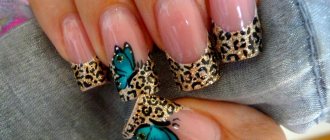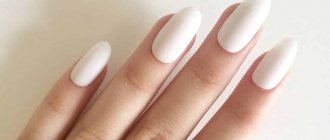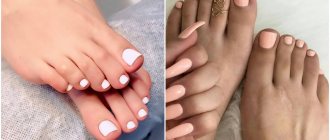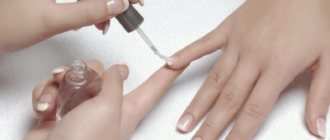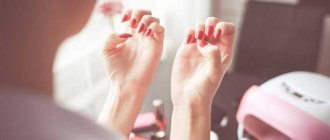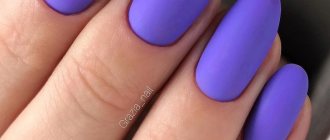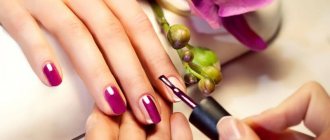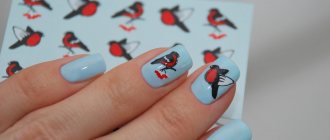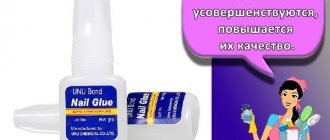Tools and materials: list
How to properly treat your nails at home? First you need to prepare all the tools and materials that may be useful during the manicure process. Stores today offer a huge selection of hand care products. To perform a manicure yourself you may need:
- nail polish remover;
- nail files;
- wooden sticks for pushing back cuticles;
- nail scissors or tweezers;
- cuticle oil;
- softening agent;
- cotton pads;
- steam bath;
- hand skin care cream;
- hand scrub;
- hydrogen peroxide;
- brush with natural bristles;
- nail polish;
- base coat (base);
- varnish fixer (finish);
- waffle towel or cotton napkin.
Secrets of choosing: nail polish remover
It is better to choose a nail polish remover that does not contain acetone, which has a negative effect on the nail plate, although it quickly washes off the old coating. With frequent use of acetone, nails begin to flake and become dull. To minimize harm, various nourishing and moisturizing components are added to the liquid (in fact, it may not be a liquid at all, but a gel or cream). Some products contain vitamins A, E, group B, essential oils, extracts of medicinal herbs, mineral ingredients (calcium) that protect the nail plate from brittleness and delamination.
Nail care
Your hands will not look well-groomed if you do not take care of the condition of your nails. The condition of your nail plate can tell you a lot about your health. Doctors will use your nail plate to determine the state of your endocrine system and gastrointestinal tract. Monitor the condition of your nails frequently.
If you have dark yellow or brown streaks on your nail plate, it means you suffer from dermatosis. Whitish spots have appeared on the nail plate, your blood circulation is impaired. If you have lung diseases, you will have convex and thick nails.
Brittle nails mean your menu contains few foods with vitamins and beneficial microelements. Nails that peel and have a faded tint will tell you about a thyroid gland disorder.
The nail plate, consisting of keratin, should be nourished. Eat fish and seafood, and dairy products containing calcium.
To prevent the cuticle (skin roller) from growing, lubricate it with a rich cream and gently move it. Keep an eye on the matrix, an important part of the nail. This is where living cells are located.
Vitamins for nails
Nails need vitamins, heifers and microelements. If you eat fermented milk products, vegetables, fruits and unrefined vegetable oil, your nails will be smooth and beautiful.
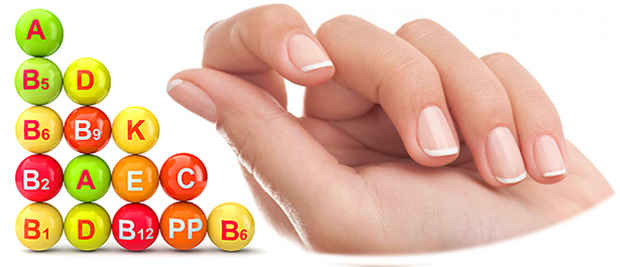
Mix 1 tablespoon of honey with milk. Regular use will have a great effect on the condition of your nails. Washing and detergents are quite harmful to nails. The nail plate will dry out and break. Wear rubber gloves.
You can strengthen your nails with a compress: mix glycerin (20 g), alum (5 g) and half a glass of water and make compresses for at least 15 days.
Nails should be treated regularly (at least one week). To do this, prepare a special nail file, manicure scissors and nail clippers. Periodically take baths with heated vegetable oil and lubricate your hands and nails with moisturizer at night.
By the shape of the nails you can find out what the owner’s character is
- Excellent self-control, love of order and self-discipline means your nails have a quadrangular shape.
- Energetic people with a sober mind have spade-shaped nails.
- Optimists who love new beginnings have rectangular nails.
- For impressionable and energetic people, the nail shape is trapezoidal.
- If you have round nails, it means you like to daydream. You have high self-esteem and constant dissatisfaction with yourself.
File, wooden sticks and scissors
It is better to buy a glass file. The tool does not act so aggressively on the nails and does not provoke separation. Polishing files may come in handy. These are made in the form of a parallelepiped. The finish and number on each side is different. You need to polish your nails one by one (depending on the edge number). The procedure should be carried out no more than once a month.
Often, disposable orange sticks are used for manicure to push back the cuticles. Orange wood is distinguished by antiseptic properties; the wood has a dense, but at the same time very soft texture, and absorbs moisture well. The length of the stick varies from 9 to 18 cm, the thickness on average is 3-5 mm. There are options with rubber tips, but the usefulness of such a tool for nails is much lower.
Wooden sticks can be replaced with metal instruments made of high-quality medical steel. They are reusable, easy to disinfect and can perform all the functions of an orange stick. But you need to use the tool very carefully, because a metal spatula can seriously damage the nail plate. Therefore, it is better to use models with rubber tips.
The size of manicure scissors or special tweezers is chosen based on the convenience of the woman herself. It is advisable to purchase tools made of high-quality steel from well-known manufacturers. Such scissors will have to be sharpened very rarely, and there will be no problems with manicure.
Preventive measures for healthy nails in old age
- Wear only comfortable shoes. For older people, it should be with a wide nose, not squeeze or restrict the toes, and made of natural, breathable materials;
- Don't try on someone else's shoes;
- Prevent your feet from sweating, change your hosiery more often if an elderly person has the habit of wearing them all the time;
- Perform foot hygiene daily;
- If necessary, take baths with herbal infusion every day. For prevention, once a week is enough;
- Do not cut your nails without first steaming;
- Do not cut deep into the corners of your nails;
- All manicure tools must be individual! Store them in a closed case and wipe them with an alcohol solution after use;
- If you notice symptoms of onychomycosis or onychocryptosis, consult your doctor immediately.
Cuticle remover, oils and scrubs
Cuticle remover, oil, scrub, cream and cotton pads can be purchased at any cosmetic store. You can use home remedies: salt and oil baths or oil massage. Oils are used cosmetic or essential. The most useful are coconut, almond, avocado or tea tree oil. Fruit acids, which are sold in pharmacies, will do an excellent job of softening the cuticle.
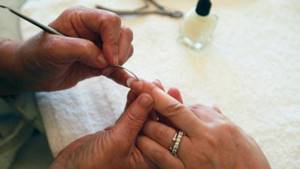
Pharmacy or home remedies
Which means to give preference to - homemade or pharmacy - remains open to this day.
Industrial pharmaceutical solutions, ointments, creams are made strictly according to the recipe, have clear instructions for use, and are purchased in a convenient form (tubes, bottles). But even with the help of homemade compositions, you can achieve the desired result using a compress kit, a small container of sufficient volume.
Every pedicurist or ordinary user should read reviews of the products of the most famous pharmaceutical companies in order to make a decision on purchasing a product for softening the nail plate. You can also find useful tips from experts on how to soften your nails for trimming.

Processing instruments in the salon
How to properly treat your nails at home? Any high-quality and safe manicure begins with the processing of tools, and not with the preparation of the nails themselves (steaming, etc.).
Processing manicure tools in beauty salons involves several stages. First, an antiseptic is rubbed into the skin of the hands to destroy pathogenic or suppress temporary microflora. How to properly handle nail trimming tools? All instruments (except for disposable ones, which must be individually packaged) are immersed in a disinfectant solution when opened or disassembled.
After disinfection, the instruments are placed in a craft bag and placed in a sterilizer. The instrument should be stored in a UV sterilizer with bactericidal lamps. Before use, manicure tools are once again sprayed with a disinfectant solution from a spray bottle.
Disinfection at home
At home, processing of nail files, tweezers and scissors is carried out before the start of the procedure and after the end of the manicure. If this is a personal manicure set, then it is enough to wipe the tools with a cotton pad generously moistened with hydrogen peroxide or alcohol. If you do manicures at home for several clients, then to comply with all the rules of disinfection and sterilization, you should purchase a compact sterilizer.
The procedures, of course, can be performed the old-fashioned way: the instruments are boiled and then calcined in the oven in sealed bags. Low-quality scissors and tweezers may become dull or bend when handled in this manner, but products made from medical steel will easily withstand all procedures.
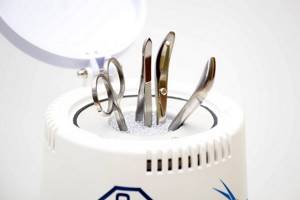
Additionally, you need to treat the hands of the master and client with an antiseptic solution. This treatment is provided only in the process of preparing healthy nail plates for manicure. If fungus is present, instruments are disinfected differently.
General safety rules
How to properly treat fingernails, hands and tools so that the manicure process is safe? The process of sterilizing instruments is described in detail above, but there are several more rules that should be followed for your own good.
All actions must be performed very carefully and slowly, because you can cut yourself or the client. It is worth asking the client in advance whether his capillaries are located close to the surface of the skin. If this is the case, then it is worth recommending an unedged manicure to avoid injury.
If you receive a “wound” in the fight for the beauty of your nails, the cut must be treated immediately. This is not a tragedy. If all manicure instruments are disinfected according to SES rules, and the wound is immediately treated, then you don’t have to be afraid of becoming infected with something dangerous.
Products for treating cuts
Usually treated with alcohol or hydrogen peroxide, but such antiseptics thin the blood. Professionals use hemostatic fluids that quickly stop bleeding and do not interfere with the quality application of varnish. You just need to moisten a cotton swab in the solution and apply it to the wound for a few seconds.
“Vagotil”, “Gemostab”, “Capramin” and “Enoji” have successfully migrated from surgery, gynecology and dentistry to the nail industry. You can use medical glue, which stops bleeding well.
“Vagotil” gives an immediate effect, but can turn the skin jaundiced. “Hemostab” not only stops bleeding, but also relieves pain. “Capramin” does not cause allergies, does not stain the skin and has no specific odor, and the box contains a very convenient pipette for dosing.
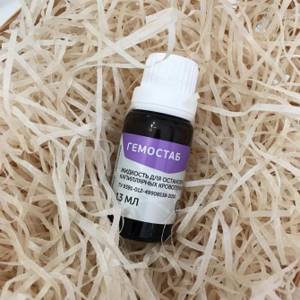
Nail treatment during trim manicure
How to properly treat your nails? First you need to prepare and disinfect all the tools that may be needed. Then you should remove the remnants of the old polish using a cotton pad and liquid (this can be a gel or cream) for removal.
The next stage is the bath. Warm water and a special filler are poured into a plastic bowl. This can be shower gel or liquid soap, essential oils, lemon juice (softens the cuticle and makes it easier to remove) or sea salt (helps strengthen nails and disinfects). If there are scratches or peeling, you should not use sea salt; it is better to replace it with chamomile decoction.
The bath should be taken for five to ten minutes. Afterwards, wipe your hands with a soft towel or blot with a paper napkin.
Next, remove the cuticle. How to properly treat your nails at home? To do this you will need an orange stick and wire cutters. Using the tip of a wooden stick, carefully push the cuticle to the edge of the nail plate, and then use pliers to trim it so that the cut is without burrs. At this stage you need to do everything very carefully. Inaccuracy can lead to infection. Any cosmetic oil or emollient is applied to the site of the removed cuticle.
How to properly treat your nails at home next? The next stage is the form. It is best to avoid using scissors and limit yourself to just a nail file. Nails should only be filed in one direction to avoid damaging the plates. The file is held at a slight angle. The treatment is carried out from the edge to the center of the nail plate.
The shape can be absolutely any. You should focus on personal preferences and fashion, which changes every season. Oval-shaped nails that protrude 3-4 mm beyond the edge of the finger always look aesthetically pleasing. Short nails make your fingers look shorter and thicker, while too long nails are simply inconvenient.

You should choose a file 15-20 cm long and 1.5-2 cm wide. This is the most convenient tool. It is better to use a soft one, because metal ones lead to nail separation. For a home manicure, it is enough to purchase one universal file.
How to properly treat your nails?
After the chosen nail shape is made, you need to prepare a bath. Pour a little vegetable oil into warm water, add a tablespoon of sea salt and a slice of lemon. Apply a cuticle softener to the cuticles and immerse your hands in water for five to ten minutes. Such a bath will not only soften the cuticle, but also strengthen the nail plate, reducing the impact of the varnish coating. Then the hands are wiped with a clean cotton towel and they begin to push back the cuticle with an orange stick or a special steel spatula.
It is worth saying that before treating your nails at home, all the tools you purchased in the store should be treated with alcohol. It is also important to remember that your tools should be yours alone. You don’t need to let your friends or even your family members use them. Many viral infections are transmitted through blood, for example, herpes, cytomegalovirus, etc. Not all people are fully informed about the state of their health, therefore, it is advisable to have an individual manicure kit.
A small cut during the procedure can leave a virus on the instruments. A sterilizer is an ideal solution for disinfecting instruments, but not everyone can purchase it. After each manicure, the instruments are treated with an alcohol solution. If there is a child in your family, then you need to purchase separate scissors for him. For a young beauty, a manicure set in a beautiful package is an excellent gift and a reason for her not to take “mom’s” scissors. And mom will always tell you how to properly treat your nails at home.

Treating nails at home can consist of moving the softened cuticle with an orange stick or cutting it off with scissors or tweezers. The length of the blades of scissors and tweezers is selected individually - depending on the size of the hand, fingers, nails, etc. Straight scissors are used to trim nails, and curved edges are used for cuticles.

If a slight injury to the skin occurs during cuticle trimming, then you need to use hydrogen peroxide. All places where hangnails are removed are also treated with peroxide. This prevents infection!
Technique for unedged manicure
How to properly treat your nails during an untrimmed manicure, and what does such a procedure entail? Unedged is suitable for those whose blood vessels are located close to the surface of the skin, and whose cuticle is thin and delicate. The main difference from a trim manicure is that the cuticle is not trimmed. It is removed using a special product.
There is no need to steam the skin of your hands before an unedged manicure, but no one has canceled the treatment of tools. How to properly treat your fingernails? You need to give your nails the desired shape with a nail file, and then begin removing the cuticle. To do this, a special composition is applied to the skin, which dissolves dead cells. After a few minutes, all that remains is to push the cuticle back and carefully remove dead skin using an orange stick. The remaining product is removed with a towel or paper napkin.
How to properly treat the skin around the nail further? You should use nourishing oil. The product should be rubbed with massage movements over the entire nail surface and into the skin around the nails. Before applying varnish, the surface must be degreased. There should be no traces of oil left at all, because otherwise the varnish will lie unevenly. A colorless base will protect your nails from pigmentation and allow the polish to last as long as possible.
Nail care in winter
Most women in winter notice that their nails become thin, brittle, tiny, and the skin of their hands becomes dry and rough. What is the reason for such changes?
Causes of brittle nails in winter
Avitaminosis. With vitamin deficiency, spots appear on the nails. This is the first sign, as they say, “on the face.” The marigolds themselves signal that they lack vitamins. To avoid this problem, you need to pay attention to your diet. Vegetables and fruits can be replaced with other products no less rich in vitamins and various microelements. You should include in your diet:
- eggs
- dairy products
- cereals
- spinach
- nuts
- fish
Air and moisture . In cold weather, human activity decreases. After all, few people want to freeze in winter. Most people are on the street in the morning, when they go to work, and in the evening, when they return from work. It can be assumed that 23 hours a day a person is in a room that is heated with dry hot air. In this case, you need to drink more water, at least 1.5 liters per day. And be sure to ventilate the work area, bedroom and kitchen.
Also, when we are sedentary, our blood circulation slows down. Metabolism in the body also slows down. Therefore, it is important to do light exercise, especially in the morning and at lunchtime. All it takes is 5-10 minutes.
Nail and hand care in salons
Paraffin therapy . Not long ago, such a service as paraffin therapy appeared in the female beauty industry. This hand and nail therapy has quickly gained popularity among women. After all, this procedure is aimed at combating dryness and flaking of the skin of the hands, preventing the appearance of micro cracks, which is especially important in winter and frost. Also, thanks to this procedure, the youth of the hands is preserved, making them smooth and soft. There are different types of paraffin therapy. It all depends on the type of skin on your hands and your own preferences.
Hand massage . With regular hand massage, the condition of the skin improves, swelling goes away, and due to blood circulation during massage, the rate of nail growth increases. This procedure also has a positive effect on the entire body. Namely: fatigue goes away, joint pain decreases, blood circulation improves.
SPA procedures . Thanks to SPA procedures, you can restore the water balance of the skin of your hands; with the help of peeling, the top dead layer of skin is exfoliated; thanks to the wrap, the skin of your hands is very well nourished and moisturized. Salons also use many different hardware techniques for nail and skin care, many baths and masks with essential oils.
Applying colored nail polish
Colored varnish is applied in a thin layer. The procedure must be repeated after a few minutes so that the first layer has time to dry. The final stage is applying a topcoat or adding additional shine. This will keep your manicure in good condition longer. It is best to buy a product from the “two in one” category, that is, one that is both a fixer and a base, and adds shine.
Many professional nail polishers recommend applying polish not immediately after a manicure, but the next day. The fact is that the steamed nail plate takes on its normal shape over time, and the varnish sets earlier. This creates an air gap between the nail and the varnish. Because of this, all the beauty breaks off literally the next day. And if you paint your nails a little later, the polish will last the required 5 days.
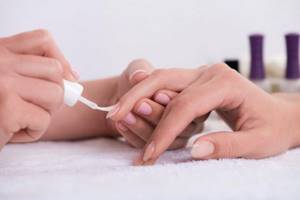
Nail design and care is a work of art
From time immemorial, women paid a lot of attention to the beauty of their hands; they not only decorated them with all kinds of jewelry, but also came up with various cosmetic procedures for them, including some similar to modern manicure. The beauties of the East painted their nails with bright colors, which included natural ingredients. Of course, no one had any idea about a manicure set, but women in China lengthened their nails using gold and silver tips.
Time has passed, technology has changed, and now nail design is something that is very popular among women of all ages. Many women simply cannot imagine their life without manicure. You can do it yourself or by going to a beauty salon. Artificial nail extension has become a very common procedure recently.
It makes it possible not only to lengthen your nails, giving them an ideal, regular shape, but also to make existing imperfections invisible. There are two technologies - acrylic and gel, which are used to simulate artificial nails.
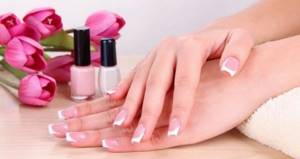
Nail designs can be absolutely anything, so every woman can choose the one that best suits the occasion, mood and preferences in general. Admirers of the classics most often prefer French manicure or the use of neutral-colored varnishes.
A professional manicurist is able to create absolutely any manicure on women’s nails; they can take on any shape; rhinestones, lace, foil, and organza can be used in their design. Nails can become a real work of art if a true specialist takes on the work.
He uses all his imagination, skill, and skills, and sometimes the results are so beautiful, such as those with a three-dimensional image, that it is impossible to take your eyes off them. To paint nails, in addition to the usual varnishes, they use water-acrylic paints, colored powders and glitter, which are applied using brushes of varying thicknesses, needles and sharpened sticks.
However, with a little practice you can design your own nails yourself. All you need for this is a manicure set, varnishes, all the necessary materials and the desire to make your nails truly magnificent and unique in their design.
Hardware manicure: tools
How to properly treat your nails with a manicure machine? This is a device that looks like a small milling machine on which you can install different attachments. The manicure technique differs only in that dead skin is removed not with hand tools, but with a mechanical device.
The machine for hardware manicure can be equipped with diamond, ceramic or silicon carbide cutters. Diamond ones are the most effective and expensive, they perfectly solve the problem of unevenness and ensure its prevention. Ceramic ones are used for problem areas and are good for pedicures. Silicon carbide cutters are the cheapest and most available, but are considered disposable and must be disposed of after the procedure.
There are different options for nozzles. A reverse cone is used to treat nails before a French manicure, a spherical bur is needed to remove small growths and cracks. A cylindrical tool is used to shorten nails, remove gel polish, create designs and other procedures.
Using a drum, rough areas are removed, thick nails are trimmed, or the growth line is straightened. Polishers are made of plastic or silicone in the form of a rounded cone. According to reviews, even for a home manicure you need to purchase four types of attachments.
Types of manicure
Today the European style , that is, a rectangular shaped nail plate. As for paints, color fashion is constantly changing. In summer, the color of ripe berries is considered extremely relevant. And for the winter, mother-of-pearl is offered in a variety of shades: pink, beige, steel. By the way, it is recommended to apply pearlescent varnish in two layers, and any other, regardless of color, in three.
The foil effect and artistic painting are also very fashionable : there can be several colors on one nail plate. Those who prefer an avant-garde style can use decals that are applied to the varnish. Rhinestones—small shiny stones—are also popular these days. Of course, on all fingers they will look vulgar, but on one finger they will look quite original and even piquant.
One of the most elegant ways to decorate your nails is French manicure . When performing a classic French manicure, a base is applied to the nails, allowed to dry, and the nails are covered with a natural-colored varnish. It is best to use transparent varnishes in delicate shades. When this varnish has dried, white varnish is applied to the tip of the nail, and then the entire free edge of the nail is covered with white varnish. It is better to start the coating from the right side edge, moving the brush to the middle of the nail, and then repeat the same on the left side. Once this coat has dried, apply one or two coats of pink polish to the entire nail, and finally coat your nails with topcoat.
Nail treatment with a machine
How to properly treat your nails with a manicure machine? There is no need to steam them, because the procedure is carried out only on a dry nail plate. The rpm is set to a speed of up to 10,000. The machine must not be pressed or put pressure on it during processing. First, it is advisable to practice on silicone tips.
So, how to properly treat your nails with the device? The cuticle is first pushed back to the nail hole with an orange stick. In this area you can use medium-hard drums. Removal of dead cells on the palms and fingers is performed using ball-shaped burs. Trapezoidal or cylindrical cutters can be used to give the nail plate the desired shape.
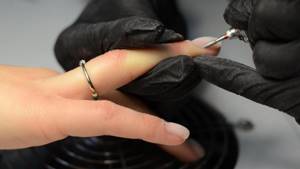
Next, how to properly treat your nails with a machine? Now you can start polishing. This is quite difficult for beginners: you cannot bring the edge of the polisher to the nail to avoid scratches, you cannot hold the tool in one place for more than one second. Next, all that remains is to remove dust and nail residues, lubricate the skin around it with oil and apply varnish.
Gel polish application technology
Many women choose gel because this coating lasts longer and prevents nails from breaking. But how to properly treat your nails before applying gel polish? First you need to give the desired shape, align the free edge of the plate and thoroughly clean it from dust. If your nails are peeling, you need to treat them with a fine abrasive nail file. Before coating, you can do a manicure, but the surface of the nail should be dry and grease-free.
How to properly treat your nails before gel polish? The top layer of the nail plate is removed with a coarse-grained buff. The surface should remain matte. Do not press too hard on the tool to avoid damaging the nail. The dehydrator further removes nail residues, dust, grease and moisture. After treatment, do not touch your nails with your fingers.
Before applying the base, it is worth covering the nail with a primer so that the adhesion of the gel polish to the nail plate is stronger. Be sure to use a primer if the plates are thin or brittle or if there are delaminations. Then a base gel is applied, which creates a bond between the natural nail and the artificial material at the molecular level, and also protects the plate from coloring pigments.
The layer should be made as thin as possible. The base is dried under an ultraviolet lamp for one minute; when using an LED lamp, only ten seconds is enough. The colored gel is applied in one layer for translucency. If you apply two or three layers, the color will be saturated. But in any case, you need to try to make the layers very thin. After each layer, the marigolds are dried under a lamp.
A finishing gel is required to secure the coating. If the finish coat is not dried properly, the shine may be lost. At the final stage, all that remains is to remove the dispersion layer from the surface of the nail plate using a special liquid.
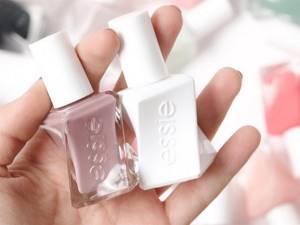
Leisure organization
Forced self-isolation is good for taking a break from some beauty treatments, using natural products to improve skin, hair, etc. But this is not a reason to give up beauty and home.
For example, well-groomed hands are an indicator of how a person treats himself and others. Manicure, in part, is also a manifestation of discipline and patience, since the procedure takes time and requires regularity.
Modern women, and often men too, go to nail salons instead of a session with a psychotherapist, and nail technicians often become their friends. And now they especially urgently ask us not to remove the overgrown long-term coating using barbaric methods, not to cut off hangnails and not to bite off nails.
How can you avoid ruining your nails and ruining your appearance during self-isolation? The owner of the nail studio, Alexandra Skoptsova, gives advice to RG readers.
— The first thing I want to share with RG readers is a life hack about hygiene. Do not forget that viruses can get not only on the skin of your hands, but also under your nails. To deal with them, we take an old toothbrush, lather it up and thoroughly clean under the nails. I advise you to use this technique not only during a pandemic, but always - germs have no place on our hands.
And now about beauty. Nails, like skin, are a reflection of our health. The main criteria for care are proper nutrition and vitamins so that the nails, cuticles and skin around them are not brittle, as well as the mandatory use of hand cream.
Many people use cosmetic oil for cuticles, but sometimes it can dry it out even more, so the most common moisturizer will do more good than newfangled products.
To make your hands look beautiful and well-groomed, you don’t need a complex set of nail technicians. For a manicure at home, you only need to have an orange wood stick and a soft file of 180 grit - this is an indicator of the abrasiveness of the file, that is, the number of abrasive particles per square centimeter of surface. The higher the number, the finer the abrasiveness and the “softer” the file. Usually, on the packaging of high-quality nail files, two numbers are indicated - these are indicators for its different sides.
A nail file is used to give the nails the desired shape, and an orange stick is needed to push back the cuticle. It is important to do this carefully, without haste and without fanaticism, so as not to damage the thin skin. If you have cuticle tweezers in your home kit, you can use them, but only if you know how to do it, otherwise there is a chance of cuts that will take a long time to heal, and this will definitely not benefit your hands. Don't forget to clean it with a stick and under your nails afterwards.
Nails grow on average one millimeter per week. This means that those who managed to get long-term coverage even before quarantine already see the need to remove it. It is not difficult to do this at home. You will need: cotton pads, foil, a nail file, an orange stick and a special gel polish remover - all of this is sold at your local supermarket or available for online delivery.
First you need to carefully file away the top layer of the finishing coat, otherwise the liquid will not dissolve all the layers. It is better to choose a softer file, from 180 grit or more.
Cotton pads can be cut into 4 parts, so they will better fit the shape of the nail. Then moisten each piece generously with nail polish remover, apply to the nail and wrap the tip of your finger tightly with foil.
You need to keep your nails in the foil for 15 to 20 minutes, after which you carefully remove the foil, one nail at a time, and clean the surface of the nail with an orange stick. If the gel polish is not completely removed, the procedure can be repeated.
After you have removed the color coating and part of the base coat, go over your nails with the softest file or buff (a bar for grinding and polishing nails). The hardness of their edges is also different, the numbers start from 220 grit. There is one nuance here. If you had your nails strengthened or straightened, then in this case you will have to file a lot, because... The liquid simply won’t take such thick layers.
It is important to know that the remover itself has a negative effect on the nails and the skin around them, so you should not abuse it. And after the removal procedure, be sure to use hand cream.
To whiten your nails, use lemon juice: if your nails are of medium length, then lemon helps whiten the overgrown part. Contrary to popular myths, lemon will not add any health to your nails, but it will definitely whiten them.
There is a lot of false information that constant manicure “spoils” your nails and dries them out. But a living nail is formed in the matrix zone, a little further than the cuticle, we do not see it. All we see is the inanimate part, therefore, if you use the services of a competent master who does not saw through the layers of the nail plate, then a permanent manicure will not bring any harm, including the application of gel polish. In addition, the nail grows on average 3-4 millimeters per month, so each new coating is done on a renewed nail plate.
Toenails also require care, especially now when it is not possible to get a professional pedicure. The skin on your feet sometimes suffers more than your hands, so it needs maximum hydration. It's good to always have a special heel rub in the bathroom, which removes old dry skin, giving your feet smoothness. This procedure can be safely done as needed, as soon as you feel discomfort, and after it, be sure to use foot cream. They tend to be thicker and greasy as they are designed specifically for foot care.
There are a couple of important rules to follow when it comes to toenails. Firstly, you need to cut and file your nails strictly straight, without rounding the corners, to avoid the problem of ingrown nails. Secondly, the file must be held perpendicular to the plane of the nail, only slightly filing the corners so that they do not interfere.
If an ingrown toenail occurs, you should contact not a manicurist and pedicurist, but a podiatrist (a specialist in foot diseases), or a specialist who has a diploma in podology (podiatrist). These are specialists with deep knowledge in the field of correction of the nail plate of the foot. There is no point in trying to solve this problem yourself at home; you can only seriously aggravate it, which in some cases even requires a difficult operation.
Pedicure
How to properly treat your toenails? During a pedicure, the nail plate is processed in the same sequence as during a manicure. First, the skin is steamed, then you need to trim your nails and cuticles. Pedicure requires treatment: care for the skin of the feet, cracked heels and calluses. How to treat toenails is clear, but what to do with rough skin?
Dead skin is removed with a pumice stone, but first you need to steam your feet in a warm bath for 10 minutes. Scrubs and peelings are great for getting rid of rough particles.
But a neglected situation cannot be corrected with a regular pedicure. To remove cracks and hardening, you need to apply a nourishing mask, wrap your feet in cellophane and put on warm socks. It is recommended to leave the mask on overnight, and in the morning wash your feet and lubricate them with nourishing cream. The result will appear only after several procedures.
Fungal nail infection - onychomycosis
Unfortunately, almost all old people suffer from this disease. The reasons for its occurrence are different, mainly vascular disorders, excessive sweating of the feet, chronic diseases (diabetes mellitus, heart and liver failure, oncology). Tight and non-breathable shoes can promote the growth of fungal microorganisms.
Onychomycosis affects the toenails and, less commonly, the fingernails. The infection is spreading rapidly. The first symptoms may be a change in the color of the nail - it becomes gray or brownish-yellow. As well as deformation of the nail plate - it thickens, crumbles, and flakes.
As soon as you notice the characteristic symptoms of a fungal infection in your elderly relative, immediately take him to a dermatologist. The disease cannot be ignored and neglected, otherwise it will affect all the toenails and spread to the soft tissues.
Therapy for onychomycosis is complex and includes antifungal and antibacterial drugs in the form of tablets and topical ointments. The duration of oral medications and their dosage will be determined by the doctor, based on the presence of chronic diseases of the elderly person. But ointments for external use should be applied until the nail is completely renewed. Sometimes, before applying the drug, it is necessary to file off the top layer of the nail plate or trim off the area of the nail affected by the fungus. Detailed instructions for use can be found on the packaging of the drug used.
The above therapy will give a positive result at the initial, not advanced stage of the disease. In cases where the damage has reached its peak and drug treatment is powerless, surgical removal of the infected nails is resorted to.
Elderly people with diabetes mellitus especially suffer from fungal infections on the nails. This is due to the fact that disturbances appear in the body’s metabolism and in the process of blood circulation. Diabetics also experience blackening of the nail plate due to increased concentrations of sugar in the blood. Most often, a patient with diabetes suffers from the lower extremities, which is why the toenails are the first to suffer changes. If there is the slightest change in the appearance of the nail, an elderly patient should seek medical help.
Nail fungus: treatment rules
How to properly treat nails with fungus? This disease requires long-term and systemic treatment. Fungal infections remain viable after washing or cleaning with conventional means; a person becomes dangerous to others and even to himself, because without proper treatment, relapses are guaranteed.
To remove the fungus, you need to regularly apply compresses, baths, use tablets and medicated varnishes. How to properly treat fungal nails? Using a sterile instrument, the nail plate is first treated with a file, and then with antifungal ointments.
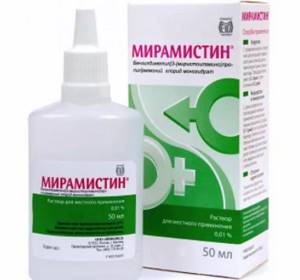
For procedures, you can use “Chlogexidine” in the form of a ready-made solution (1%). Use a cotton pad to thoroughly wipe the inside of the shoes, the insole, and all tools for manicure and pedicure. Socks need to be boiled in a special solution or treated with a pharmaceutical antifungal drug.
Baths for strengthening nails
As a standard, girls rarely use baths to strengthen and grow their nails, since now they often apply a decorative coating in the form of gel polish, which visually thickens them, making them stronger. This prevents their premature breakdown.
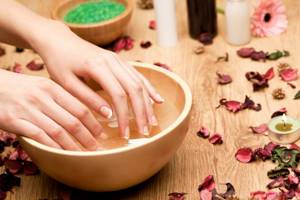
However, it is important to do home manipulations to strengthen the surface of the plate; they have several positive aspects:
- They contain natural ingredients that help restore the balance of microelements, vitamins and nutrients in the structure.
- Often baths for nail growth include a massage for the fingers, which stimulates blood flow, which accelerates their growth.
- Quick results. With daily use of home recipes, after a week the girl may notice their effect: the nail plate becomes denser and begins to grow quickly.
- Increasing the dullness of the surface ensures that the decorative coating (varnish, gel polish) lasts much longer. It does not break off or chip for more than a month after a manicure.
Strengthening baths for nails have different effects, so first take into account their composition and the manipulations that need to be additionally carried out with your fingers.
Treatment agents for mycosis
How to properly treat toenails if you have fungus? You can use pharmacy “Miko-stop”, “Miramistin”, “Dezavid”, “Laina” and the already mentioned “Chlorhexidine”. Myko-stop spray is suitable for emergency disinfection. “Miramistin” - this drug is used in a large number of cases, including for treating shoes. “Dezavid” is available in the form of a solution and spray. Can be used after nail removal. “Laina” is used on household items, but shoes must be dried after treatment.
Onychocryptosis - ingrown toenail
Onychocryptosis is the ingrowth of the nail plate into the lateral tissue of the nail, otherwise into the periungual fold. The disease is accompanied by acute local pain, swelling and redness of the affected area of the skin. Most often, the big toes suffer from onychocryptosis. In older people, this is due to natural age-related changes in the nail plate (its thickening), with valgus deformity of the big toe, or from wearing uncomfortable narrow shoes. Another main cause of the disease is the consequence of onychomycosis: if the corners of the nail are affected by the fungus, then they have to be cut off deeply, which subsequently leads to improper growth of the nail plate.
In the first stages of the disease, pain occurs under the influence of external factors (when walking, when pressing on the nail). Further pain will occur at rest. In the absence of special treatment, onychocryptosis often recurs and a number of complications appear, for example, gangrene or abscess of the finger.
To diagnose the disease, you need to see a doctor. If all the symptoms and characteristic complaints of an elderly patient are present, the doctor will determine the stage of the disease during examination. If the possibility of complications is established, the old man will be subjected to additional diagnostics, which will include a general blood test (to check for the presence of an inflammatory process in the body) and an X-ray of the foot (to clarify the anatomical features and exclude purulent inflammation).
If you seek help from a specialist in a timely manner, conservative therapy will be prescribed. Among other things, it will be recommended to reduce the load on the sore foot, walk without shoes more often, apply cold and compresses based on antiseptic and anti-inflammatory solutions to the inflamed area. In other cases, treatment is possible only through surgery.
